
Maitland Web Design: Incorporating User Feedback for Iterative Improvement
In today’s digital landscape, creating an exceptional user experience is crucial for the success of Maitland-based businesses. One compelling way to deal with accomplish this is by integrating client input into the website composition process. By actively listening to user insights and iteratively improving the website based on their feedback, businesses in Maitland can enhance usability, increase customer satisfaction, and drive better business outcomes. This article explores the importance of user feedback in web design and provides practical tips for Maitland businesses to effectively incorporate it for iterative improvement.
- The Value of User Feedback: User feedback offers invaluable insights into how visitors perceive and interact with a website. It provides Maitland businesses with a deeper understanding of user preferences, pain points, and areas for improvement. By incorporating user feedback, businesses can align their web design decisions with user expectations, leading to a more intuitive and engaging user experience.
- Collecting User Feedback: There are various methods to collect user feedback, such as surveys, user testing sessions, heatmaps, and analytics data. Maitland businesses can leverage these techniques to gather qualitative and quantitative feedback. Surveys and user testing sessions allow direct communication with users, while heatmaps and analytics data provide valuable insights into user behavior.
- Analyzing and Prioritizing Feedback: Once user feedback is collected, it’s essential to analyze and categorize the feedback based on common themes and priority levels. This helps Maitland businesses identify recurring issues and determine which areas of the website require immediate attention. Prioritizing feedback ensures that the most critical improvements are addressed first.
- Iterative Improvement: With user feedback insights in hand, Maitland businesses can make informed design changes and updates to address user concerns. Implementing these improvements in iterative cycles allows for continuous enhancements, making the website more user-friendly over time. Regularly testing and monitoring the impact of changes further ensures positive results.
- Engaging Users in the Process: Involving users in the web design process creates a sense of ownership and fosters a positive relationship between businesses and their Maitland customers. Seeking user feedback early on, conducting user testing sessions, and actively communicating updates or changes demonstrate that businesses value their users’ opinions and are committed to delivering an exceptional user experience.
- Continuous Evaluation: Web design is an ongoing process, and Maitland businesses should continuously evaluate user feedback and website performance. Regularly monitoring analytics data, conducting A/B testing, and seeking feedback on new features or design iterations enable businesses to adapt and optimize their websites based on evolving user needs and preferences.
Conclusion: Incorporating user feedback into the web design process is vital for Maitland businesses to create user-centric websites that drive engagement, satisfaction, and business growth. By actively listening to users, collecting feedback, and iteratively improving the website, businesses can stay ahead of the competition, deliver exceptional user experiences, and build long-lasting relationships with their Maitland customers. Embracing user feedback as a catalyst for iterative improvement is a strategic approach that leads to continuous enhancement and success in the dynamic digital landscape.
Q1: Why is user feedback important in web design for Maitland businesses?
A1: User feedback provides insights into user preferences, pain points, and expectations, helping Maitland businesses create user-centric websites that enhance the overall user experience.
Q2: How can Maitland businesses collect user feedback for web design?
A2: Maitland businesses can collect user feedback through surveys, user testing sessions, heatmaps, and analytics data. These methods provide qualitative and quantitative insights into user behavior and preferences.
Q3: How should Maitland businesses analyze and prioritize user feedback?
A3: Maitland businesses should analyze user feedback by identifying common themes and prioritizing based on the frequency and impact of the issues raised. This helps determine which improvements should be addressed first.
Q4: What is iterative improvement in web design?
A4: Iterative improvement involves making design changes based on user feedback and continuously enhancing the website over time. It allows Maitland businesses to address user concerns and refine the user experience through multiple improvement cycles.
Q5: How can Maitland businesses engage users in the web design process?
A5: Maitland businesses can engage users by seeking their feedback early on, conducting user testing sessions, and communicating updates or changes. Involving users fosters a sense of ownership and ensures the website meets their needs.
Q6: How often should Maitland businesses evaluate user feedback and website performance?
A6: Maitland businesses should continuously evaluate user feedback and website performance. Regular monitoring of analytics data, conducting A/B testing, and seeking feedback on new features help optimize the website based on evolving user needs.
Q7: What are the benefits of incorporating user feedback in web design for Maitland businesses?
A7: Incorporating user feedback leads to improved user satisfaction, increased engagement, and better business outcomes. It helps Maitland businesses align their website with user expectations and build strong relationships with their customers.
Contact us at @ Bottrell Media
93 Lawes St, East Maitland NSW 2323
P: 02 40275782
E: office@bottrellmedia.com.au
Socials & Links for Bottrell Media
Facebook – Bottrell Media Facebook Page
Instagram – Bottrell Media Instagram Page
Google – Bottrell Media Google
Helpful articles
The Value of User Experience in Website Design
How a focus on user experience leads to increased engagement, conversions, and customer satisfaction
Professional Services (Links)


